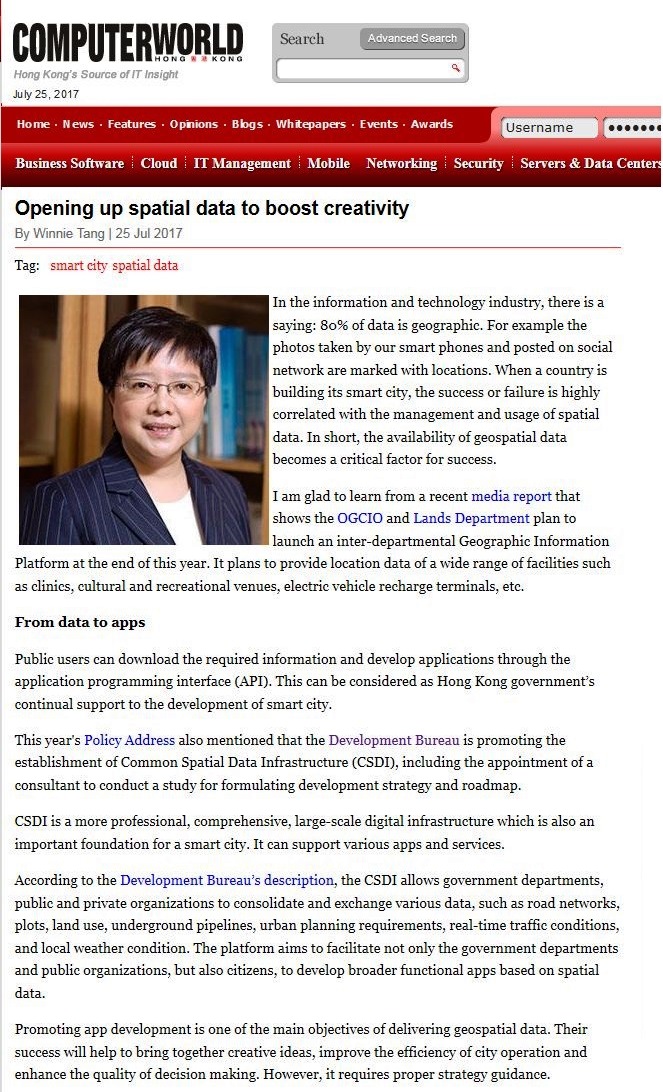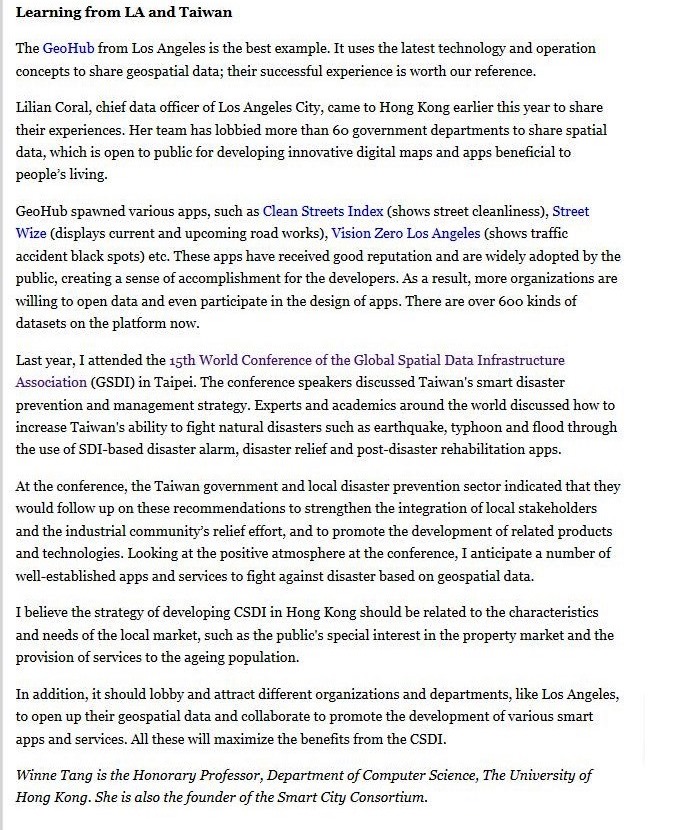網上版請按此


Opening up spatial data to boost creativity
In the information and technology industry, there is a saying: 80% of data is geographic. For example the photos taken by our smart phones and posted on social network are marked with locations. When a country is building its smart city, the success or failure is highly correlated with the management and usage of spatial data. In short, the availability of geospatial data becomes a critical factor for success.
I am glad to learn from a recent media report that shows the OGCIO and Lands Department plan to launch an inter-departmental Geographic Information Platform at the end of this year. It plans to provide location data of a wide range of facilities such as clinics, cultural and recreational venues, electric vehicle recharge terminals, etc.
From data to apps
Public users can download the required information and develop applications through the application programming interface (API). This can be considered as Hong Kong government's continual support to the development of smart city.
This year's Policy Address also mentioned that the Development Bureau is promoting the establishment of Common Spatial Data Infrastructure (CSDI), including the appointment of a consultant to conduct a study for formulating development strategy and roadmap.
CSDI is a more professional, comprehensive, large-scale digital infrastructure which is also an important foundation for a smart city. It can support various apps and services.
According to the Development Bureau's description, the CSDI allows government departments, public and private organizations to consolidate and exchange various data, such as road networks, plots, land use, underground pipelines, urban planning requirements, real-time traffic conditions, and local weather condition. The platform aims to facilitate not only the government departments and public organizations, but also citizens, to develop broader functional apps based on spatial data.
Promoting app development is one of the main objectives of delivering geospatial data. Their success will help to bring together creative ideas, improve the efficiency of city operation and enhance the quality of decision making. However, it requires proper strategy guidance.
Learning from LA and Taiwan
The GeoHub from Los Angeles is the best example. It uses the latest technology and operation concepts to share geospatial data; their successful experience is worth our reference.
Lilian Coral, chief data officer of Los Angeles City, came to Hong Kong earlier this year to share their experiences. Her team has lobbied more than 60 government departments to share spatial data, which is open to public for developing innovative digital maps and apps beneficial to people's living.
GeoHub spawned various apps, such as Clean Streets Index (shows street cleanliness), Street Wize (displays current and upcoming road works), Vision Zero Los Angeles (shows traffic accident black spots) etc. These apps have received good reputation and are widely adopted by the public, creating a sense of accomplishment for the developers. As a result, more organizations are willing to open data and even participate in the design of apps. There are over 600 kinds of datasets on the platform now.
Last year, I attended the 15th World Conference of the Global Spatial Data Infrastructure Association (GSDI) in Taipei. The conference speakers discussed Taiwan's smart disaster prevention and management strategy. Experts and academics around the world discussed how to increase Taiwan's ability to fight natural disasters such as earthquake, typhoon and flood through the use of SDI-based disaster alarm, disaster relief and post-disaster rehabilitation apps.
At the conference, the Taiwan government and local disaster prevention sector indicated that they would follow up on these recommendations to strengthen the integration of local stakeholders and the industrial community's relief effort, and to promote the development of related products and technologies. Looking at the positive atmosphere at the conference, I anticipate a number of well-established apps and services to fight against disaster based on geospatial data.
I believe the strategy of developing CSDI in Hong Kong should be related to the characteristics and needs of the local market, such as the public's special interest in the property market and the provision of services to the ageing population.
In addition, it should lobby and attract different organizations and departments, like Los Angeles, to open up their geospatial data and collaborate to promote the development of various smart apps and services. All these will maximize the benefits from the CSDI.
Dr. Winnie Tang
Honorary Professor, Department of Computer Science, The University of Hong Kong